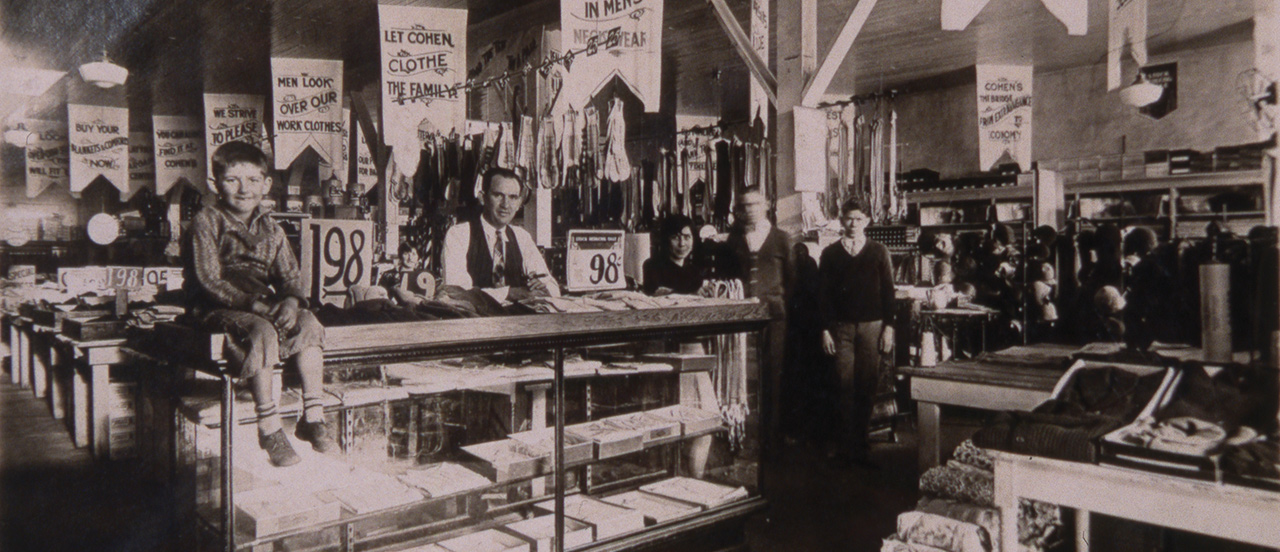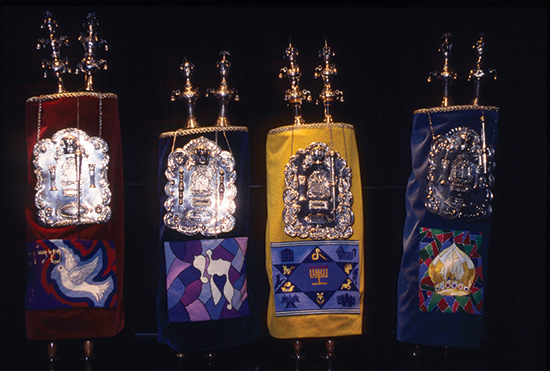

By 1865 approximately 85 Jewish families were living in Florence and nearby towns. In 1857 Moritz Jacobi, an emigrant from Denmark, moved to the village of Florence and established a hotel on Front Street called the Jacobi House (1857–1938). Pharmacist John Kuker opened a successful store in 1866 and served as a warden (councilman) and as Florence’s second intendant (mayor). Abram Weinberg moved to Florence in 1871 and launched a general merchandise store. He also served as a warden. David Sternberger arrived in 1872 and established a retail store. He and Isaac Sulzbacher, a jeweler, joined other community leaders in lobbying for the creation of Florence County—an effort that proved successful in 1888.
On October 26, 1887, David Sternberger, Julius DeJongh, S. Elias, and Harris Joseph applied to the state of South Carolina for incorporation of the Florence Hebrew Benevolent Association “to unite the Hebrews of Florence and surrounding country into a fraternal and benevolent association, to assist needy Israelites, and to purchase and maintain a suitable burying ground.” Within a month the association had purchased land for $50.00 from the Northeast Railroad Company and the first burial had taken place—six-year-old Rebecca Sternberger of Darlington, David Sternberger’s niece. In 1889 Adolphus A. Cohen made a motion to order books and establish a Sunday school for “all children of Israelite parents,” whether or not they were members of the association. Thus began a religious school that continues today.
Part of the vast emigration from Eastern Europe at the turn of the 20th century, a small number of Orthodox Jews found their way to Florence. In 1912 Beth Israel Congregation was incorporated, with B. Patz, M. Rosenfeld, and I. Silverman named as trustees, holding services in various places around the city. The same year five women formed the Ladies Aid Society with the primary purpose of providing Sunday school classes for the children. Within ten years it became clear that the community could not support two congregations and, in 1922, the Hebrew Benevolent Association and Beth Israel agreed to merge. Sunday school classes and Reform services were to be held once a month; High Holy Day services would follow the Orthodox tradition. Rabbi Jacob Raisin of Charleston’s Kahal Kadosh Beth Elohim was hired to make the trip to Florence one Sunday a month and served as Beth Israel’s spiritual leader until his death in 1946. He had been coming to Darlington since 1919 to lead Sabbath services and started splitting his day between the two communities.
Worship services were held on the second floor of Zeigler’s Drug Store on the corner of Dargan and Evans streets. Sam and Hannah Semless of Philadelphia, grandparents of Nathanial Rosenfeld, donated the first Torah in honor of Nat’s parents, Maurice and Mae Rosenfeld. In 1926 the Beth Israel Sisterhood, formerly the Ladies Aid Society, affiliated with the National Federation of Temple Sisterhoods. The following year land on East Elm Street was purchased to build a temple, but was later sold to the city to build Florence High School. The congregation met in various buildings in Florence, including the Rainwater Building, the YMCA, and the Masonic Temple. In April 1931 Beth Israel affiliated with the Union of American Hebrew Congregations (UAHC).
In February 1949 plans were laid to construct a new religious facility to be located on land on Park Avenue donated by Dr. Michael Morse, a pharmacist. With blueprints provided by UAHC, Dr. Morse, Dr. S. Abe Greenberg, and Isadore Stein managed construction of the temple, which was completed in July 1949. Rabbi Philip Frankel of Charlotte led the formal dedication service for the congregation, numbering about 25 families at the time.
The small congregation could not afford to hire a full-time spiritual leader and relied on the parttime services of rabbis from Columbia, Sumter, and Charlotte. As Florence grew after World War II, the Jewish population increased and, in 1952, Beth Israel was able to hire Rabbi Tibor Fabian. The next year Rabbi Morris Clarke assumed the pulpit and added a musical dimension to services with performances by a newly organized choir. Rabbi Avery Jonah Grossfield served the congregation from 1954 to 1958, followed by two student rabbis, Jay Krouse and Paul Kushner, both of Hebrew Union College in New York City. Every two weeks one of these young men flew to Florence to lead services and hold religious school classes. Next came Rabbi Eli Gottsman, a circuit-riding rabbi who traveled by bus among congregations in the Carolinas. Rabbi Charles B. Lesser arrived in 1961 and served the congregation as full-time rabbi until 1970.
During Lesser’s tenure the congregation grew from some 50 families to 70. Over this decade the Jewish community of Florence increased from 160 to around 285 and the occupational profile shifted from mercantile pursuits to the professions. The Men’s Club of Beth Israel, established in 1958 and affiliated with the National Federation of Temple Brotherhoods, agreed in 1973 to amalgamate with the Sisterhood and the Temple Affiliates was born—the first merger of its kind in the nation and a model for this type of cooperative effort.
In 1967 the growing congregation, needing room for expansion, purchased two small houses adjacent to the temple and made plans to add classrooms and a new kitchen and to enlarge the social hall and sanctuary. Funds were raised, the small houses demolished, and in early 1969 a groundbreaking ceremony was held. Construction was completed in June 1970, and Beth Israel’s new rabbi, Howard Folb, ordained only four months earlier, officiated at the dedication service in October of that year.
Rabbi Folb remained with Beth Israel for 11 years and brought a youthful spirit to the congregation. Young Jewish families moving to the area found the active congregation with its newly renovated facilities met their social as well as spiritual needs. The religious school was flourishing, offering a well-rounded Jewish education for their children. In the late 1970s Beth Israel absorbed the membership of Darlington’s congregation, which had slowly been diminishing, and became a full-service congregation and the center for Judaism in the Pee Dee area. Though affiliated with the Reform movement, the congregation and its rabbis have tried to be flexible regarding tradition and practices so that everyone would be comfortable in the synagogue.
Rabbi Sidney Strome, who replaced Rabbi Folb in July 1981, was a learned scholar who gave lovely sermons. Well liked by the congregation, he and his wife enjoyed socializing and often entertained congregants at their home. His health failing, Rabbi Strome retired in July 1984, but remained in Florence until his death in 1990.
Strome’s successor, Rabbi Lawrence Mahrer, remained with the congregation until January 1995. During his tenure the face of the congregation changed. Many children who were raised in Beth Israel, having graduated from college, settled out-of-state to pursue careers. Older congregants, who ran stores or worked in manufacturing, especially textiles, were outstripped by young professionals, such as physicians, recruited by local medical centers or newer industries. Ohav Shalom, Dillon’s Conservative congregation, had been slowly shrinking in size; the congregation closed its doors in 1993 and sold the building, bequeathing its artifacts and most of its congregants to Beth Israel. By the mid-1990s Florence’s membership numbered over 90 families, with more than 50 children attending religious school.
Rabbi Mahrer understood what UAHC had to offer and how to utilize it for a small congregation. He encouraged congregants to become involved in regional and national committees; he pushed hard to establish Beth Israel’s endowment fund, started in 1991 with seed money donated by Arthur and Shirley Siegal, interest from which now provides a significant portion of Beth Israel’s operating budget. Mahrer saw the importance of endowing small congregations, as young congregants tended to move to the larger cities after their education. Recognizing the importance of lay leadership, he arranged for two congregants to be trained as “rabbinic aides” in a UAHC program, enabling them to assist the rabbi and be able to perform life-cycle events in his absence. His ten years in Florence helped stabilize the congregation.

Rabbi Marc Kline came to Beth Israel in the summer of 1995, introducing more Hebrew and more traditional practices, a strong commitment to social justice, and deep involvement in community activities. To boost participation he helped organize a volunteer choir and encouraged the children to take part in worship services, some of which he wrote himself. With his departure in 2003, the congregation struggled to find a full-time rabbi willing to lead a small-town southern temple. Malcolm Cohen, a student rabbi at the Leo Baeck School in London, came to Beth Israel twice a month for a year while he took courses at Hebrew Union College in New York. Rabbi Alvin Sugarman, retired senior rabbi from The Temple in Atlanta, filled in as parttime rabbi, with lay leaders teaching in the religious school and conducting many worship services.
In 2005 Beth Israel succeeded in hiring Rabbi Jeffrey Ronald who, during his six-year tenure, brought a deep knowledge of Jewish thought, wisdom, and works to the congregation. He set a shining example in personal morals and kindness. Actively representing the congregation in community affairs, he brought a Jewish presence to interdenominational events and social justice activities.
Since 2011 Beth Israel has employed two parttime rabbis—Rabbi Aaron Sherman of Charleston and Rabbi Leah Doberne-Schor of Columbia—both of whom were brought to their respective cities by the jobs of their spouses in the rabbinate and academia. Each rabbi comes to Florence once a month to lead services, officiate at life-cycle events, and teach in the Sunday school. Based in Jackson, Mississippi, the Institute of Southern Jewish Life supplements their leadership with periodic visits from an education fellow who conducts services and provides religious school and adult programs. When no rabbi is present, lay leaders officiate on Friday nights.
Beth Israel maintains its affiliation with the Union for Reform Judaism (URJ, formerly UAHC) and has been represented on its North American board of trustees since 1999. Synagogue members attend URJ events and the congregation continues to serve as a pilot site for the newest generation of prayer books issued by the Central Conference of American Rabbis. Beth Israel also prides itself on its choir, comprised of both congregants and non-Jewish singers and musicians who offer a large repertoire of Jewish music.
Over the last decade the congregation’s membership has dwindled as textile and apparel manufacturing has moved overseas and retail businesses have lost their lure among the younger generation of more highly educated Jews. The children of professionals, whose influx in the 1980s and 1990s swelled the religious school, are now grown and gone. In 2012 membership hovers just above 50 families hailing from the Pee Dee towns of Florence, Darlington, Marion, Mullins, Latta, Dillon, and Clio, as well as Laurinburg, North Carolina.
Sources:
• Beth Israel Congregation, Our History, “Temple Beth Israel – Then and Now,” by Beatrice K. Rogol, http://www.sc001.urj.net/ourHistory.html
• The Goldring/Woldenberg Institute of Southern Jewish Life, History Department, Encyclopedia of Southern Jewish Communities, “Florence, South Carolina,” by Alyssa Neely, http://www.isjl.org/history/archive/sc/florence.html
• Eliza Cowan Ervin and Horace Fraser Rudisill, Darlingtoniana, The R. L. Bryan Company, Columbia, SC, 1964.
• Eugene N. Zeigler, Village to City, Florence, South Carolina 1853–1893, Clio Press, Inc. Florence, SC, 2008.